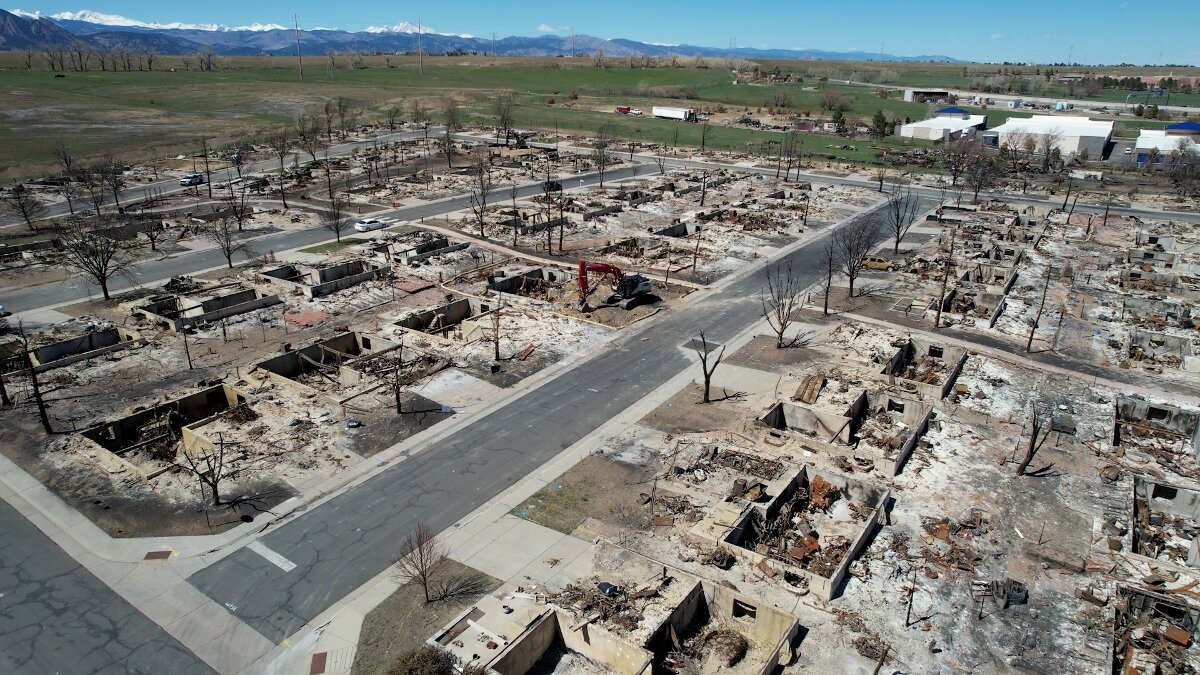Marshall Fire ignited by previously buried embers and Xcel power line, investigators conclude

BOULDER, Colo. — After 18 months, the Boulder County Sheriff’s Office released its report on the Marshall Fire, the most destructive fire in Colorado history.
Sheriff Curtis Johnson announced during a June 8 press conference that the Marshall Fire had two ignition points: previously buried embers that reignited on a property along Eldorado Springs Drive, as well as an “unmoored” Xcel Energy power line.
Johnson’s voice broke during the press conference as he held back tears. “I get a little emotional still about the impact that [the Marshall Fire] has had on my family,” the sheriff said. His home burned down in the fire. It was one of more than 1,000 houses that the fire destroyed.
Boulder County District Attorney Michael Dougherty announced that his office is not filing any criminal charges because it could not find any evidence that a crime took place.
“We make our decisions about charging criminal offenses based on evidence, and not based on emotion,” Dougherty said. “What I want to just really stress to the community is if we were to tell you today that we were filing charges, it would be wrong and unethical.”
Sheriff Johnson provided extensive details on the origin of the flames that started on the Eldorado Springs Drive property: On Dec. 24, 2021 — six days before the Marshall Fire — residents on that property started a fire to burn scrap wood and branches. A passerby reported the fire to Boulder County officials, who then investigated the fire and found that the residents were not doing anything improper; the residents had a water source nearby and there was not a burn ban in place on that day. Moreover, the residents said they were going to bury the embers and ash once the fire was out, which they did.
However, the 100 mph wind gusts six days later exposed the buried embers, which still retained heat. Once they were exposed to oxygen, the embers caught fire on the surrounding vegetation, which led to the start of the Marshall Fire.
Dougherty said that in speaking with wildfire experts, his office learned that smoldering combustion can occur for weeks, even months, when buried.
The second ignition point for the Marshall Fire was just south of the Marshall Mesa Trailhead, Johnson said. The investigation found that the most likely cause was hot particles discharged from a disconnected Xcel energy power line.
And while Johnson said the underground coal mines in the area cannot be entirely “ruled out” as the cause of the fire, he said the investigation concluded it is “more likely than not” that the power line is to blame.
Johnson said investigators were initially unaware of the disconnected power line because Xcel repaired it in the days after the fire in order to restore power to the area, which was affected by snow.

There is no evidence that Xcel repaired the line as a way to impede the investigation, Dougherty said, but the district attorney made a point to note that Xcel could have been clearer in its communication with the DA’s office.
Dougherty clarified that the bar for filing a civil case is lower than a criminal one. But again, he emphasized that criminal charges are not going to happen.
“I imagine some people would cheer that decision because of how much people have suffered in this community. That cheering would come to an abrupt stop in about six weeks” when a judge would dismiss the case due to a lack of evidence, he said.
“This investigation took longer than was anticipated and I appreciate your patience," Johnson added. “I know personally the last 18 months have been hard, and not having answers creates stress and challenges that we don’t need. And I hope that now we can focus on rebuilding our lives and getting back to our homes and our community.”
The full investigative report will be published on the Boulder County Sheriff’s Office website.
It is difficult to overstate the Marshall Fire’s devastation. The fire destroyed more than 1,000 homes, killing two people. And it did so with horrifying efficiency: the fire burned over 6,000 acres in about six hours. At one point, the flames jumped over a six-lane highway. Homes that weren’t even near the flames were still heavily damaged by smoke and winds.
As Rocky Mountain PBS reported previously, experts believe it would be a mistake to dismiss the Marshall Fire as a series of freak accidents. Continued heat waves, drought and suburban sprawl in the western United States means the conditions that helped the Marshall Fire become the most destructive in our state’s history are not going away any time soon.
Kyle Cooke is the digital media manager for Rocky Mountain PBS. You can reach him at kylecooke@rmpbs.org.
